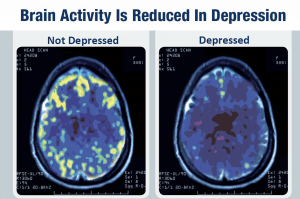 Mental illness is something that is becoming more and more common – especially depression. It is something that is diagnosed in a majority of people seeking therapy. However, with new forms of technology, it is allowing us to view and experience the new ways in which MRI scanning can recognize many different, distinct brain characteristics to reveal the brain’s symptoms of depression (Paddock, 2019). According to the article, “New MRI Scans Reveal Brain Features of Depression”, written by Catharine Paddock, she states that researchers have found that their observations of the brain with using this new technology will aid in finding deeper knowledge on depression and how it affects one’s brain (Paddock, 2019). In addition, they are also hoping to find out more about the proper treatments that can help to cure someone with depression (Paddock, 2019). Specifically, one of the newest MRI’revealed differences in the blood barrier (BBB) and the other MRI found many other differences in the brain’s strategic network of connections (Paddock, 2019). BBB is a set of distinctive properties in the brain’s blood vessels that permit them to control the movement of molecules and cells between them and the tissues that they serve (Paddock, 2019). Similarly, depression is more than just a feeling of sadness in someone’s day-to-day life (Paddock, 2019). It can actually turn into a serious issue for someone, leading to self-harm and even suicide (Paddock, 2019). Suicide is the most severe form of depression that can hopefully be reduced by the new MRI techniques (Paddock, 2019). A recent presentation, founded by RSNA 2019, concluded that depression affects more than 264 million people worldwide (World Health Organization, 2019; as cited in Paddock, 2019). The most common type of depression is Major Depressive Disorder (MDD) (Paddock, 2019). Typically, someone with MDD tends to feel hopeless, fatigue, and loss of attentiveness to certain activities that were once easily performed (Paddock, 2019). Kenneth T. Wengler, a researcher who works in the Department of Psychiatry at Columbia University, examined connections between MDD and changes to BBB (Paddock ,2019). His research resulted in the finding that current treatments for MDD have a high relapse rate (Paddock, 2019). Therefore, this result being the reason why utilizing this new technology is pertinent. We would be able to use this new technology as a tool to find better treatments for depression – ones without a high relapse rate.
Mental illness is something that is becoming more and more common – especially depression. It is something that is diagnosed in a majority of people seeking therapy. However, with new forms of technology, it is allowing us to view and experience the new ways in which MRI scanning can recognize many different, distinct brain characteristics to reveal the brain’s symptoms of depression (Paddock, 2019). According to the article, “New MRI Scans Reveal Brain Features of Depression”, written by Catharine Paddock, she states that researchers have found that their observations of the brain with using this new technology will aid in finding deeper knowledge on depression and how it affects one’s brain (Paddock, 2019). In addition, they are also hoping to find out more about the proper treatments that can help to cure someone with depression (Paddock, 2019). Specifically, one of the newest MRI’revealed differences in the blood barrier (BBB) and the other MRI found many other differences in the brain’s strategic network of connections (Paddock, 2019). BBB is a set of distinctive properties in the brain’s blood vessels that permit them to control the movement of molecules and cells between them and the tissues that they serve (Paddock, 2019). Similarly, depression is more than just a feeling of sadness in someone’s day-to-day life (Paddock, 2019). It can actually turn into a serious issue for someone, leading to self-harm and even suicide (Paddock, 2019). Suicide is the most severe form of depression that can hopefully be reduced by the new MRI techniques (Paddock, 2019). A recent presentation, founded by RSNA 2019, concluded that depression affects more than 264 million people worldwide (World Health Organization, 2019; as cited in Paddock, 2019). The most common type of depression is Major Depressive Disorder (MDD) (Paddock, 2019). Typically, someone with MDD tends to feel hopeless, fatigue, and loss of attentiveness to certain activities that were once easily performed (Paddock, 2019). Kenneth T. Wengler, a researcher who works in the Department of Psychiatry at Columbia University, examined connections between MDD and changes to BBB (Paddock ,2019). His research resulted in the finding that current treatments for MDD have a high relapse rate (Paddock, 2019). Therefore, this result being the reason why utilizing this new technology is pertinent. We would be able to use this new technology as a tool to find better treatments for depression – ones without a high relapse rate.
After reading this article, you may be thinking about the sense of motivation that is being exhibited by the researchers for those with depression. How can someone be so motivated to do something with no favor in return? An explanation for this would be altruism. Altruism refers to the idea of being determined and motivated to grow the well-being of another person without thinking about oneself and how you can benefit from it. In this instance, the researchers are exhibiting altruism. With this new technology, their immediate response to it was to use it to help find more effective treatments for people with depression. No where in the article did they mention how this new technology can help advance their careers as researchers; although it can, the researchers are not aware of it as they are too focused on and motivated as to how it can help those with depression.
Another concept that relates to this theory is the idea of having a superordinate goal. A superordinate goal is defined as a goal that is shared across multiple people that requires cooperation and ignores the differences between the multiple people working on this same, shared goal. The idea of having a superordinate goal can relate to the conversations being had and the discoveries in this news article. Between the researchers, doctors, and medical professionals working and researching on this new technology – they all share a superordinate goal. They do because the work they are doing requires cooperation amongst all of the members of the research team. If cooperation is not present, they would be unable to continue to find the benefits of this new technology and the advancements that come with it. In addition, this news article also exhibits evidence of a superordinate goal because no matter the amount/kind of education, gender, or race of each research member – they are all sharing a common goal. That is, finding new treatments that are more effective and helpful to people with depression. Therefore, since they share such motivation towards this common goal already, their levels of status and differences do not individually or collectively matter to them. For example, the author of this article is a female and she included information and advancements for this new technology founded by men. Although they are of different genders, Paddock did not pay attention to this gender difference due to the motivation and cooperation that all three of them have to help find better treatments with the new technology.
References
Paddock, C. (2019, December 4). New MRI scans reveal brain features of depression. Retrieved December 5, 2019, from https://www.medicalnewstoday.com/articles/327220.php#1.
Carmela Piccolo


 On the week of November 20th, it was announced that Gabrielle Union and Julianne Hough would not be returning to judge America’s Got Talent. Whether they were fired or quit depends on the article you read, but the reason behind them not coming back has roots in prejudice and discrimination towards women especially. Prejudice is defined as a negative judgement towards a group and its members and discrimination is taking an action based on those judgments. It has been reported that coworkers at America’s Got Talent have made hurtful remarks towards Union and Hough which lead to them leaving the show.
On the week of November 20th, it was announced that Gabrielle Union and Julianne Hough would not be returning to judge America’s Got Talent. Whether they were fired or quit depends on the article you read, but the reason behind them not coming back has roots in prejudice and discrimination towards women especially. Prejudice is defined as a negative judgement towards a group and its members and discrimination is taking an action based on those judgments. It has been reported that coworkers at America’s Got Talent have made hurtful remarks towards Union and Hough which lead to them leaving the show.





